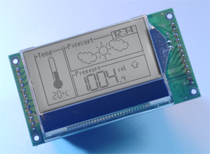|
|
|
JControl - Java for Embedded Systems
|
| |
| |
|
 Short development cycles, high code reuse rates, reliability – these are attributes generally associated with the Java™ programming language. With JControl®, you can take advantage of these features in embedded systems programming, without loosing on performance or memory efficiency. Short development cycles, high code reuse rates, reliability – these are attributes generally associated with the Java™ programming language. With JControl®, you can take advantage of these features in embedded systems programming, without loosing on performance or memory efficiency.
|
| Features at a Glance |
| |
- Very short Start-up Time
- High degree of scalability
- Portable to any 32 bit microcontroller
- Supporting Freescale's ColdFire Architecture
- Comprehensive support of Peripheral Components
- Comfortable Integrated Development Environment with complete Simulation
|
|
|
JControl - Optimized for Compactness
| |
| |
|
|
JControl is a very compact software platform for Embedded Systems, portable to any 32 bit systems. You don't even need an operating system, because JControl may run directly on the hardware ("bare bone"). This will reduce "friction losses" and ensure very short start-up times. Numerous software libraries are available, optimized for the use in Embedded Systems, reducing the development efforts to the minimum.
|
|
 A reason for the compactness of JControl is in the extremely efficient interface between the virtual Java Machine and the hardware-dependent software: Many Java Methods (e.g. drawing methods) are native (written in "C") and may be called directly by the virtual machine. The most compact JControl variant (JCVM8) runs even on an 8 bit microcontroller, needing 60k ROM and 2.5k RAM. The JCVM32 for 32 bit systems is more demanding in this respect, but it offers much more functionality. A full-featured configuration of the JControl firmware containing drivers and libraries for all supported peripheral devices (e.g. for display, touch, network, USB, TCP/IP etc.), costs approx. 420kB of flash memory. Additionally, 64kB for the starter application are needed. The starter takes care of system initialization and the launching of the JControl firmware on power-up. Optionally, a stand-alone bootloader may be included (approx. 256k), facilitating complete software updates (e.g. via network, USB or a serial interface). A reason for the compactness of JControl is in the extremely efficient interface between the virtual Java Machine and the hardware-dependent software: Many Java Methods (e.g. drawing methods) are native (written in "C") and may be called directly by the virtual machine. The most compact JControl variant (JCVM8) runs even on an 8 bit microcontroller, needing 60k ROM and 2.5k RAM. The JCVM32 for 32 bit systems is more demanding in this respect, but it offers much more functionality. A full-featured configuration of the JControl firmware containing drivers and libraries for all supported peripheral devices (e.g. for display, touch, network, USB, TCP/IP etc.), costs approx. 420kB of flash memory. Additionally, 64kB for the starter application are needed. The starter takes care of system initialization and the launching of the JControl firmware on power-up. Optionally, a stand-alone bootloader may be included (approx. 256k), facilitating complete software updates (e.g. via network, USB or a serial interface).
|
|
|
|
 The JControl API (Application Programming Interface) has been customized to the special requirements of embedded applications. Next to basic classes for general programming tasks, it offers various functionalities for controlling local peripheral components, like graphic displays, touch panels, network devices, serial interfaces, RTC, etc. Additional software libraries are included for assisting in different application areas. This includes graphical user interfaces, gateways or control systems with field bus connectivity. The JControl API (Application Programming Interface) has been customized to the special requirements of embedded applications. Next to basic classes for general programming tasks, it offers various functionalities for controlling local peripheral components, like graphic displays, touch panels, network devices, serial interfaces, RTC, etc. Additional software libraries are included for assisting in different application areas. This includes graphical user interfaces, gateways or control systems with field bus connectivity.
|
Integrated Development Environment JControl/IDE
| |
| |
|
|
.png) The JControl/IDE (Integrated Development Environment) is the common development environment for JControl. Based on Eclipse technology, it includes software tools for supporting the application development, e.g dedicated image, music, and font editors. Additionally, a compiler with optimizer and a comprehensive communication interface is integrated, enabling the upload an application directly to the device – using the network, serial interface or USB. The JControl/IDE (Integrated Development Environment) is the common development environment for JControl. Based on Eclipse technology, it includes software tools for supporting the application development, e.g dedicated image, music, and font editors. Additionally, a compiler with optimizer and a comprehensive communication interface is integrated, enabling the upload an application directly to the device – using the network, serial interface or USB.
|
|
One of the highlights of the JControl/IDE is the integrated simulation environment. It allows the simulation of JControl applications at any development stage. The platform independence of JAVA provides a maximum of proximity to reality: For the simulation phase, only the class libraries of the JControl system are replaced with their simulated counterparts. Next to the plain simulation of hardware components such as displays, touch screens or IO ports, the simulation can even use PC hardware components (like RS232 interfaces) as substitutes for the hardware components of the "real" target device.
|
|